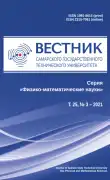Математическое моделирование и численный метод оценки характеристик неизотермической ползучести по результатам эксперимента
- Авторы: Зотеев В.Е.1
-
Учреждения:
- Самарский государственный технический университет
- Выпуск: Том 25, № 3 (2021)
- Страницы: 531-555
- Раздел: Математическое моделирование, численные методы и комплексы программ
- URL: https://journal-vniispk.ru/1991-8615/article/view/79691
- DOI: https://doi.org/10.14498/vsgtu1871
- ID: 79691
Цитировать
Полный текст
Аннотация
Стремление к уменьшению массы машин и конструкций при улучшении их качества, а также к наиболее полному использованию механических свойств материалов требует постоянного совершенствования и развития известных методов расчета и анализа напряженно-деформированного состояния материалов в условиях ползучести.
В статье предлагается численный метод оценивания характеристик третьей стадии неизотермической ползучести по совокупности диаграмм ползучести, построенных при обработке результатов испытаний для различных значений номинального напряжения и температур.
В основе метода лежат нелинейные регрессионные модели, среднеквадратичные оценки параметров которых находятся посредством линеаризации, в том числе на основе разностных уравнений, описывающих результаты наблюдений. Предлагаемый численный метод может быть также использован для оценки параметров третьей стадии ползучести, когда результаты эксперимента в форме совокупности диаграмм испытаний представлены только для одной температуры.
Приведены результаты апробации разработанного численного метода при обработки результатов эксперимента в форме диаграмм ползучести сплава 09Г2С при различных температурах. Достоверность и эффективность представленных в работе алгоритмов вычислений и методов нелинейного оценивания подтверждаются результатами численно-аналитических исследований и построенными на основе экспериментальных данных математическими моделями третьей стадии неизотермической ползучести.
Об авторах
Владимир Евгеньевич Зотеев
Самарский государственный технический университет
Автор, ответственный за переписку.
Email: zoteev-ve@mail.ru
ORCID iD: 0000-0001-7114-4894
SPIN-код: 8547-1223
Scopus Author ID: 16456013300
ResearcherId: D-8245-2014
http://www.mathnet.ru/person38585
доктор технических наук, доцент; профессор; каф. прикладной математики и информатики
Россия, 443100, Самара, ул. Молодогвардейская, 244Список литературы
- Работнов Ю. Н. Избранные труды. Проблемы механики деформируемого тела. М.: Наука, 1991. 196 с.
- Работнов Ю. Н. Ползучесть элементов конструкций. М.: Наука, 1966. 752 с.
- Малинин Н. Н. Прикладная теория пластичности и ползучести. М.: Машиностроение, 1975. 400 с.
- Малинин Н. Н. Расчеты на ползучесть элементов машиностроительных конструкций. М.: Машиностроение, 1981. 220 с.
- Локощенко А. М. Ползучесть и длительная прочность металлов. М.: Физматлит, 2016. 504 с.
- Бойцов Ю. И., Данилов В. Л., Локощенко А. М., Шестериков С. А. Исследование ползучести металлов при растяжении. М.: МГТУ им. Н. Э. Баумана, 1997. 98 с.
- Соснин О. В., Горев Б. В., Никитенко А. Ф. Энергетический вариант теории ползучести. Новосибирск: Ин-т гидродинамики СО РАН СССР, 1986. 95 с.
- Соснин О. В., Любашевская И. В., Новоселя И. В. Сравнительные оценки высокотемпературной ползучести и разрушения конструкционных материалов // ПМТФ, 2008. № 2. С. 123–130.
- Самарин Ю. П., Клебанов Я. М. Обобщенные модели в теории ползучести конструкций. Самара: СамГТУ, 1994. 196 с.
- Самарин Ю. П. Построение экспоненциальных аппроксимаций для кривых ползучети методом последовательного выделения экспоненциальных слагаемых // Проблемы прочности, 1974. № 9. С. 24–27.
- Радченко В. П. Математическая модель неупругого деформирования и разрушения металлов при ползучести энергетического типа // Вестн. Сам. гос. техн. ун-та. Сер.Физ.-мат. науки, 1996. № 4. С. 43–63. https://doi.org/10.14498/vsgtu237
- Радченко В. П., Еремин Ю. А. Реологическое деформирование и разрушение материалов и элементов конструкций. М.: Машиностроение-1, 2004. 264 с.
- Радченко В. П., Симонов А. В. Разработка автоматизированной системы построения моделей неупругого деформирования металлов на основе методов непараметрического выравнивания экспериментальных данных // Вестн. Сам. гос. техн. ун-та. Сер. Физ.-мат. науки, 1999. № 7. С. 51–62. https://doi.org/10.14498/vsgtu208
- Катанаха Н. А., Семенов А. С., Гецов Л. Б. Единая модель долгосрочной и краткосрочной ползучести и идентификация ее параметров // Проблемы прочности, 2013. № 4. С. 143–157.
- Belleneger E., Bussy P. Phenomenological modeling and numerical simulation of different modes of creep damage evolution // Int. J. Solids Struct., 2001. vol. 38, no. 4. pp. 577–604. https://doi.org/10.1016/S0020-7683(00)00042-1
- Besseling J. F. Plasticity and creep theory in engineering mechanics / Topics in Applied Continuum Mechanics. Vienna: Springer, 1974. pp. 115–135. https://doi.org/10.1007/978-3-7091-4188-5_6
- Benedetti M., Fontanari V., Scandi P., Ricardo C.L.A., Bandini M. Reverse bending fatigue of shot peened 7075-T651 aluminium alloy: The role of residual stress relaxation // Int. J. Fatigue, 2009. vol. 31, no. 8–9. pp. 1225–1236. https://doi.org/10.1016/j.ijfatigue.2008.11.017
- Draper N. R., Smith H. Applied Regression Analysis / Wiley Series in Probability and Statistics. New York: John Wiley and Sons, 1998. xix+716 pp. https://doi.org/10.1002/9781118625590
- Демиденко Е. З. Линейная и нелинейная регрессии. М.: Финансы и статистика, 1981. 302 с. [Demidenko E. Z. Lineinaia i nelineinaia regressii [Linear and Nonlinear Regressions]. Moscow: Finance and Statistics, 1981. 302 pp. (In Russian)]
- Зотеев В. Е., Макаров Р. Ю. Численный метод определения параметров модели ползучести разупрочняющегося материала // Вестн. Сам. гос. техн. ун-та. Сер. Физ.-мат. науки, 2016. Т. 20, № 2. С. 328–341. https://doi.org/10.14498/vsgtu1488
- Зотеев В. Е., Макаров Р. Ю. Численный метод оценки параметров деформации ползучести при степенной зависимости параметра разупрочнения от напряжения // Современные технологии. Системный анализ. Моделирование, 2016. № 3 (51). С. 18–25.
- Грановский В. А., Сирая Т. Н. Методы обработки экспериментальных данных при измерениях. Л.: Энергоатомиздат, 1990. 288 с.
- Себер Дж. Линейный регрессионный анализ. М.: Мир, 1980. 456 с.
- Вучков И., Бояджиева Л., Солаков О. Прикладной линейный регрессионный анализ. М.: Финансы и статистика, 1987. 238 с.
- Зотеев В. Е. Параметрическая идентификация диссипативных механических систем на основе разностных уравнений. М.: Машиностроение, 2009. 344 с.
- Зотеев В. Е. Численный метод нелинейного оценивания на основе разностных уравнений // Вестн. Сам. гос. техн. ун-та. Сер. Физ.-мат. науки, 2018. Т. 22, № 4. С. 669–701. https://doi.org/10.14498/vsgtu1643
- Бойко С. В. Моделирование формообразования элементов конструкций в условиях нестационарной ползучести: Дис. ... канд. физ.-мат. наук. Новосибирск: Ин-т гидродинамики им. М. А. Лаврентьева, 2020. 133 с.
Дополнительные файлы






